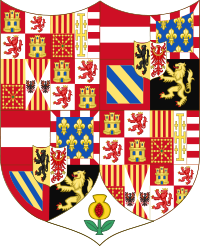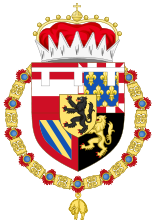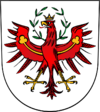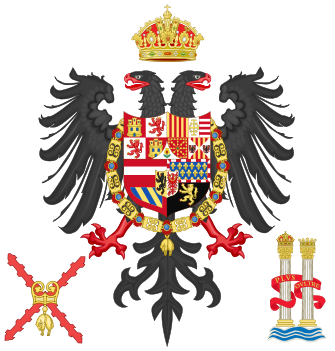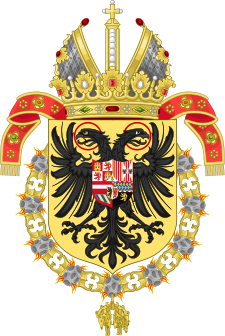- Coat of arms of Charles V, Holy Roman Emperor
-
Coat of arms of Charles V, Holy Roman Emperor 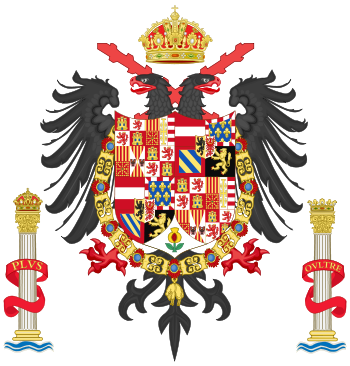
Details Armiger Charles V, Holy Roman Emperor, Charles I as King of Spain Adopted 1516 Crest Imperial Crown of Austria Torse Cross of Burgundy Escutcheon His maternal inheritance quartering his paternal inheritance Supporters Imperial Eagle and the Pillars of Hercules Motto Plus Ultra
(Latin areas)
Plus Oultre
(German and Burgundian areas)Orders Order of the Golden Fleece Charles V, Holy Roman Emperor, or Charles I of Spain, was the heir of four of Europe's leading royal houses. He was the first sole monarch of Spain, inheriting the kingdoms first united by his maternal grandparents, Isabella I of Castile and Ferdinand II of Aragon (the Catholic Monarchs). From his father, Philip I of Castile, he inherited the Burgundian Netherlands, which came from his paternal grandmother, Mary of Burgundy. Finally, on the death of his paternal grandfather, Maximilian I, Holy Roman Emperor, he inherited the Habsburg lands in Austria. His coat of arms, representing much of the land he inherited, is blazoned as follows:
“ Quarterly: I and IV grand-quarterly i and iv great-grand-quarterly 1 and 4 gules a three towered castle Or masoned sable and ajouré azure (for Castile), 2 and 3 argent a lion rampant purpure crowned Or langued and armed gules (for Leon), ii per pale, dexter per fess, in chief Or four pallets gules (for Aragon), in base gules a cross, saltire, and orle of chains linked together Or and a centre point vert (for Navarre), sinister party per pale argent a cross potent and four crosslets Or impaling barry of eight gules and argent (for Naples), iii per pale, dexter per fess, in chief Or four pallets gules (for Aragon), in base gules a cross, saltire, and orle of chains linked together Or and a centre point vert (for Navarre), sinister per saltire, 1 and 4 Or four pallets gules, 2 and 3 argent an eagle displayed sable (for Sicily); II and III grand-quarterly, i gules a fess argent (for Austria), ii azure semy-de-lis Or a bordure compony argent and gules (new Burgundy), iii bendy of six Or and azure a bordure gules (old Burgundy), iv sable a lion rampant Or langued and armed gules (for Brabant), overall at the fess point of the quarter an inescutcheon Or a lion rampant sable armed and langued gules (for Flanders) impaling argent an eagle displayed gules, armed, beaked, and langued Or (for Tyrol); enté en point argent a pomegranate proper seeded gules, supported, sculpted and slipped vert (for Granada). Supporters: A bicephalous eagle displayed sable imperially crowned proper in front of a saltire ragulée gules, the whole between two columns argent issuing from the sea proper in base, the one to dexter crowned imperially proper, the one to sinister crowned with the Royal Crown of Spain proper. The motto, PLVS VLTRA or PLVS OVLTRE, wraps around the columns.
” Contents
Personal arms
The upper half represents Spanish holdings: the left-hand side shows the Castile and Leon quartering, with Aragon and Sicily on the right, and the Granada pomegranate at the bottom between the two. After 1520 the Aragon/Sicily quarter also incorporated the arms of Jerusalem, a titular claim, Naples, and Navarre (not shown but detailed below).
The lower half represents Austrian holdings: the left-hand side shows Austria over "Old" Burgundy, with "New" Burgundy over Brabant on the right, and the inescutcheon in the middle showing Flanders on the left and Tyrol on the right.
The imperial arms were based on the personal ones with grand quartering reduplication, and augmentation with various heraldic elements as detailed below.
Features
First and Fourth Quarters First and Fourth Grand-quarters Second Grand-quarter Arms Meaning Details 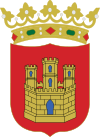
Kingdom of Castile 1st and 4th great-grand-quarters
Gules, a three towered castle Or, masoned sable and ajouré azure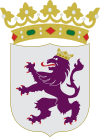
Kingdom of León 2nd and 3rd great-grand-quarters
Argent, a lion rampant purpure(sometimes blazoned gules) crowned Or, langued and armed gulesThird Grand-quarter 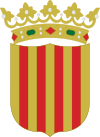
Kingdom of Aragon Dexter chief
Or, four pallets gules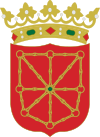
Kingdom of Navarre Dexter base
Gules, a cross, saltire and orle of chains linked together Or, a centre point vert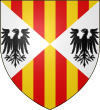
Kingdom of Sicily Sinister side
Party per Saltire, Or four pallets gules and Argent an eagle displayed sable (Manfred of Sicily)Arms Meaning Details 
Kingdom of Aragon Dexter chief
Or, four pallets gules
Kingdom of Navarre Dexter base
Gules, a cross, saltire and orle of chains linked together Or, a centre point vert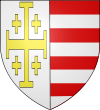
Kingdom of Naples Sinister side
Party per pale Argent, a cross potent and four crosslets Or Barry of eight Gules and Argent (Kingdom of Jerusalem) and
Barry of eight Gules and Argent (Kingdom of Hungary).[1]Second and Third Quarters Arms Meaning Details 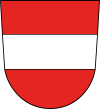
Austria 1st grand-quarter
Gules a fess Argent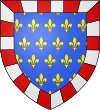
County of Burgundy
(Free County of Burgundy)2nd grand-quarter
azure semy de lis or, a bordure compony gules and argent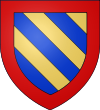
Duchy of Burgundy
(Old Burgundy)3rd grand-quarter
bendy of six or and azure a bordure gulesArms Meaning Details 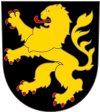
Duchy of Brabant 4th grand-quarter
Sable, a lion rampant Or, langued and armed gulesEscutcheon 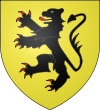
County of Flanders Dexter
Or, a lion rampant of Sable, langued and armed gulesTyrol Sinister
Argent an eagle displayed gules, armed, beaked, and langued OrExternal Oraments Arms Meaning Details 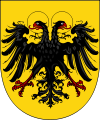
Double-headed eagle
(Holy Roman Empire)Imperial Eagle
Double-headed eagle displayed Sable
Cross of Burgundy
(Duchy of Burgundy)Mantling
blazoned Argent, a saltire ragulée gules.Arms Meaning Details 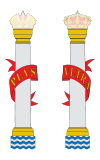
Pillars of Hercules Supporters
an ancient name given to the Strait of Gibraltar. The personal motto of the Monarch plus ultra, means 'further beyond' in Latin at Spanish and Italian territories. Plus oultre, in French was common in German and Burgundian areas.
Imperial crown (Holy Roman Empire,
Austrian version)Crown
King's Charles I of Spain crown. He was also Holy Roman Emperor Charles V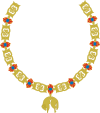
Golden Fleece Collar
Order of chivalry founded in 1430 by Duke Philip III of Burgundy to celebrate his marriage to the Portuguese princess Isabel of Aviz.The Burgundian Inheritance and the Order of the Golden Fleece
In 1477, the territory of the Duchy of Burgundy had been conquered and annexed by France. In the same year, Mary "the Rich", the last Burgundian duke's only child, had married Charles' grandfather Maximilian, giving the Habsburgs control of the remainder of the Burgundian Inheritance: although the territory of the Duchy of Burgundy itself remained in the hands of France, the Habsburgs remained in control of the title of Duke of Burgundy and the other parts of the Burgundian inheritance, notably the Low Countries and the Free County of Burgundy in the Holy Roman Empire. They often used the term Burgundy to refer to it until the late 18th century, when the Austrian Netherlands were lost to the French Republic. Although Charles V had inherited the grand mastership of numerous orders, the only order which he habitually wore and awarded was that of the Burgundian Order of the Golden Fleece.
Gallery
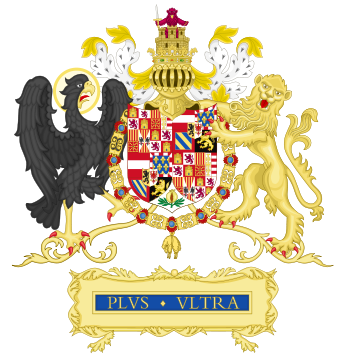

Coat of Arms of Charles when he was Duke of Burgundy and King of Navarre, Castile and Aragon (Version with motto and supporters)References
- (Spanish) Gavira Ignacio, Origins and history of the Spanish coat of arms.
Categories:- Austrian coats of arms
- German coats of arms
- Spanish coats of arms
- Personal coats of arms
Wikimedia Foundation. 2010.

